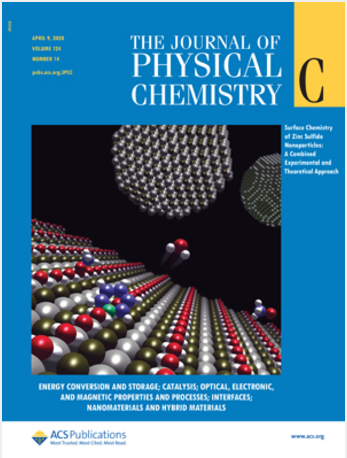溶解氧对悬浮WO3纳米颗粒光致变色的影响
IF 3.3
3区 化学
Q2 CHEMISTRY, PHYSICAL
引用次数: 0
摘要
我们报道了通过多元醇途径合成接近wo3的纳米颗粒(NPs),在某种意义上,所制备的NPs除了具有光致变色性能外,还具有氧化学计量缺陷(因此WO3-x公式更准确)。用1-丁基膦酸对其表面进行修饰,可防止其在水中分散时水解。功能化NPs的水悬浮液在紫外线照射下不表现出任何光致变色,不像乙醇中的NPs具有强烈的可逆光致变色对比。这一差异归因于乙醇中的溶解氧含量,乙醇中的溶解氧含量是水的16.5倍。大量的溶解氧使乙醇不仅可以作为氧化剂(在漂白中),还可以作为还原剂(在着色中),而水对氧的亲和力较低,使其成为非常差的氧化还原溶剂。通过丁酮、辛醇和二甲基甲酰胺三种溶解氧含量远高于水的混悬液的紫外照射,进一步证明了氧对WO3 NPs的光致变色性(以特征着色和漂白次数为标准)的影响。所选择的溶剂与分子氧的亲和力越大,光致变色就越快(因此也就越“有效”)。本文章由计算机程序翻译,如有差异,请以英文原文为准。

Effect of Dissolved O2 on the Photochromism of Suspended WO3 Nanoparticles
We report the synthesis by a polyol route of close-to-WO3 nanoparticles (NPs), in the sense that the as-prepared NPs have a deficiency in oxygen stoichiometry (a WO3–x formula is therefore more accurate), as a key point in addition to their photochromic properties. Their surface modification with 1-butylphosphonic acid was shown to prevent their hydrolysis when dispersed in water. The aqueous suspensions of the functionalized NPs do not exhibit any photochromism under UV irradiation, unlike those in ethanol, which have a strong and reversible photochromic contrast. This difference has been attributed to the dissolved oxygen content, which is 16.5 times higher in ethanol than in water. This high amount of dissolved oxygen allows ethanol to act not only as an oxidizing agent (in bleaching) but also as a reducing agent (in coloring), whereas the water’s low affinity for oxygen makes it a very poor redox solvent. The effect of oxygen on the photochromism (in terms of characteristic coloring and bleaching times) of the WO3 NPs was further evidenced through the UV irradiation of suspensions in butanone, octanol, and dimethylformamide, all chosen because their dissolved oxygen content is much higher than that of water. Photochromism is all the more rapid (and therefore “effective”) the greater the affinity of the chosen solvents with molecular oxygen.
求助全文
通过发布文献求助,成功后即可免费获取论文全文。
去求助
来源期刊

The Journal of Physical Chemistry C
化学-材料科学:综合
CiteScore
6.50
自引率
8.10%
发文量
2047
审稿时长
1.8 months
期刊介绍:
The Journal of Physical Chemistry A/B/C is devoted to reporting new and original experimental and theoretical basic research of interest to physical chemists, biophysical chemists, and chemical physicists.
 求助内容:
求助内容: 应助结果提醒方式:
应助结果提醒方式:


